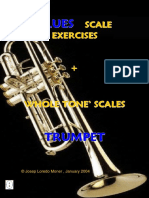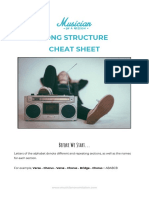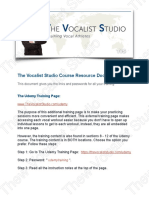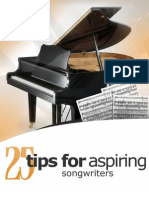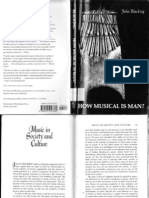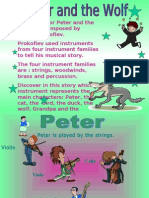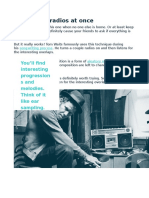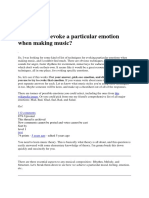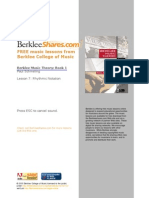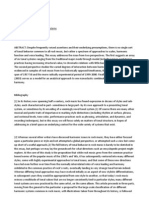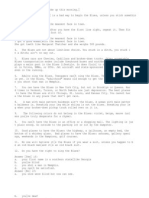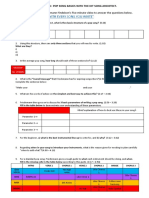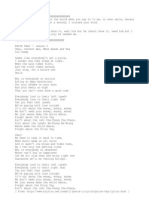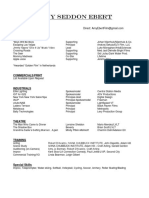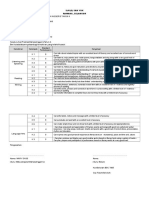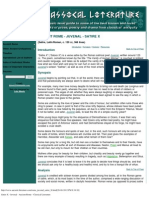Song Mapping
Song Mapping
Uploaded by
api-147409220Copyright:
Available Formats
Song Mapping
Song Mapping
Uploaded by
api-147409220Original Title
Copyright
Available Formats
Share this document
Did you find this document useful?
Is this content inappropriate?
Copyright:
Available Formats
Song Mapping
Song Mapping
Uploaded by
api-147409220Copyright:
Available Formats
Jeff Israel Music- Songwriting 9/10/2012
Song Mapping
Song Mapping is a process by which a listener or songwriter can quickly sketch the overall form of a song. It uses shorthand and symbols to break the song into readily understandable sections, in order for other musicians and/or the songwriter himself to be able to follow along & remember the structure of the song. It also helps reveal problems, provide ideas and context for further creation, and allow for reflection and serious consideration of ones own songwriting process. Song mapping generally consists of two stages: structure & chord progression/phrasing. During the structural phase, the songwriter or listener divides the song into sections, either using A-B notation (for songs with many parts or without lyrics, jazz or classical songs, etc) or V-C notation (for more standard songs & much popular music). In V-C notation, we have the following general symbols & meanings: I- Introduction: While occasionally unrelated thematically to the body of the song, introductions often present one or more of the compositions central motives, usually in a slightly altered condition. They serve to establish the style, tonality, timbre, and instrumentation of the song, and can be anywhere from very short (one or two beats) to several minutes. V- Verse: The equivalent of a poetic stanza, the verse is often the storytelling moment in the song. Verse to verse, the lyrics typically change while the melody remains more or less similar. Verses usually contain less instrumentation & focus more on the singers voice (than choruses). P- Prechorus: The prechorus is a short harmonic or thematic introduction to the chorus. It is used as a transition from the sound of the verse (or Bridge) to the sound of the chorus (this can include instrumentation, rhythm, melody, harmony, etc). C- Chorus: The chorus is generally the thesis statement of the song, containing its strongest message and fullest sound & instrumentation. Often repeated several times throughout the song, the chorus usually remains roughly the same in lyrics and melody. Choruses frequently also signal a key change or modulation. B- Bridge: The bridge is a harmonically & stylistically distinct section of the song that serves to provide contrast to the rest of the tune. Bridges are often in a different key, a different time signature, a new tempo, a new dynamic, and/or contain different instruments/production. Successful bridges may or may not maintain motivic relation to the rest of the song. Extreme motivic shifts can constitute a breakdown (Br or BD) as opposed to a bridge.
O- Outro: The outro is used to send the song to its end. Outros regularly include vamping (or the repetition of a line, phrase, or motive), fadeouts or decrescendos, and/or reduction of instrumentation/layering. Sometimes, outros are extended and linked into the intro for a new song. When these sections repeat, the symbols can acquire subscripts to indicate slight changes in a general repetition: V1, V2, etc.
A basic song map could look like this: I-V1-V2-P-C-V3-P-C-B-V4-P-C-O
Extended song mapping is called chartingcharting is the addition of specific lengths and chord changes to the basic structure. Sections are represented in bar lengths, like so : | 8 |. Chord symbols and important licks (short specific melodies) are added each time the chord changes. A given 16-bar verse may look like this: C Am F G G7
V: | 4 | | 4 | | 4 ||2||2| Charts are usually written on manuscript paper.
You might also like
- Brick A World HistoryDocument3 pagesBrick A World Historydharmabum80No ratings yet
- Song Structure PDFDocument2 pagesSong Structure PDFLeoni Pepe D'Adderio100% (1)
- Blues Scale Exercices Trumpet (Demo)Document24 pagesBlues Scale Exercices Trumpet (Demo)Josep Loredo80% (5)
- Write Your Own Rap LyricsDocument3 pagesWrite Your Own Rap LyricsRyan MaierNo ratings yet
- Song Structure Cheat Sheet: Before We Start..Document4 pagesSong Structure Cheat Sheet: Before We Start..Jaime SaldanhaNo ratings yet
- 002 The Vocalist Studio Resource DocumentDocument4 pages002 The Vocalist Studio Resource DocumentSantiago Herrera PalacioNo ratings yet
- Notion 4 ShortcutsDocument3 pagesNotion 4 ShortcutsQuinn MasonNo ratings yet
- Writing Better LyricsDocument20 pagesWriting Better LyricsAnonymous kDMD6iAp4FNo ratings yet
- 25 Song Writing TipsDocument23 pages25 Song Writing TipsSong Erra100% (4)
- Blacking - J - How Musical Is ManDocument36 pagesBlacking - J - How Musical Is ManCheyorium Complicatorum100% (2)
- Peter and The Wolf 2 PPPDocument36 pagesPeter and The Wolf 2 PPPinma.I.classNo ratings yet
- Week 5 - Song Form and Production MappingDocument19 pagesWeek 5 - Song Form and Production Mappingapi-263507178100% (1)
- Structure in Classical MusicDocument6 pagesStructure in Classical MusicLovetamin SweetchildrenbanddotkomNo ratings yet
- Song Structure Cheat SheetDocument4 pagesSong Structure Cheat SheetNIYOR100% (1)
- 12-Bar Blues in EDocument3 pages12-Bar Blues in EBrentley CauthenNo ratings yet
- Song WritingDocument4 pagesSong Writingjomari estraNo ratings yet
- How To Write Songs That Stand Out From The CrowdDocument6 pagesHow To Write Songs That Stand Out From The CrowdBrankko SiqueiraNo ratings yet
- Song Exploder Dua Lipa Love Again EpisodeDocument4 pagesSong Exploder Dua Lipa Love Again EpisodeTim GeaneyNo ratings yet
- How Do You Evoke A Particular Emotion When Making Music - WeAreTheMusicMakersDocument11 pagesHow Do You Evoke A Particular Emotion When Making Music - WeAreTheMusicMakersplaaspaddas3No ratings yet
- 7 Chord Progressions That Work All The Time - The Essential Secrets of SongwritingDocument10 pages7 Chord Progressions That Work All The Time - The Essential Secrets of SongwritingTony de SouzaNo ratings yet
- How To Arrange A SongDocument1 pageHow To Arrange A SongNicholas ThamNo ratings yet
- Song Writing Booklet Y7Document10 pagesSong Writing Booklet Y7Hannah Young0% (1)
- Berklee Shares - Writing ChorusDocument4 pagesBerklee Shares - Writing ChorusOtávio PitelliNo ratings yet
- The Elements of A Great Pop Song - FromDocument4 pagesThe Elements of A Great Pop Song - Frompaulkriesch0% (1)
- Writing A Memorable MelodyDocument3 pagesWriting A Memorable MelodyEmilio Palazzolo DublancNo ratings yet
- How Is This Song Put Together Name: Yukiko Grade: 9 Artist: Kelly Clarkson Song Title: Because of You Tempo: 70 Beats Per Min. Time Signature: 4/4Document3 pagesHow Is This Song Put Together Name: Yukiko Grade: 9 Artist: Kelly Clarkson Song Title: Because of You Tempo: 70 Beats Per Min. Time Signature: 4/4api-298370598No ratings yet
- Berklee Rhythm NotationDocument4 pagesBerklee Rhythm NotationCarla Bozzi0% (1)
- Songwriters Workshop-What Makes A Good Song PDFDocument3 pagesSongwriters Workshop-What Makes A Good Song PDFMathew Wooyoung ChongNo ratings yet
- Songwriting Checklist PDFDocument2 pagesSongwriting Checklist PDFLucLaMotNo ratings yet
- Break My Heart:: How To Dial Up The Emotional Appeal of Your SongsDocument10 pagesBreak My Heart:: How To Dial Up The Emotional Appeal of Your SongsJaime SaldanhaNo ratings yet
- Classroom Listening ActivityDocument19 pagesClassroom Listening ActivityMary LinNo ratings yet
- Making Sense of Rock's Tonal SystemsDocument34 pagesMaking Sense of Rock's Tonal Systemspolkmnnl100% (1)
- How To Write A Song - Vol IDocument27 pagesHow To Write A Song - Vol IErik FigueroaNo ratings yet
- Expanding On A MelodyDocument4 pagesExpanding On A Melodyplaaspaddas3No ratings yet
- Vocal MechanicsDocument31 pagesVocal MechanicsMelanie CainNo ratings yet
- Berklee Pentatonic For WritersDocument5 pagesBerklee Pentatonic For WritersCuco LocoNo ratings yet
- How To Sing The BluesDocument2 pagesHow To Sing The Bluesconfederate1956No ratings yet
- Songwriting ChecklistDocument2 pagesSongwriting ChecklistLucLaMotNo ratings yet
- Cantus Firmus Principles of Melodic MotionDocument2 pagesCantus Firmus Principles of Melodic MotionAnonymous Jy9y9NMN100% (1)
- Do This With Every Song You WriteDocument1 pageDo This With Every Song You Writekorkster0% (1)
- Songwriting Guide Ebook 2021Document31 pagesSongwriting Guide Ebook 2021petercmjonesNo ratings yet
- Vocal Lyric WritingDocument7 pagesVocal Lyric WritingKabir Akeem100% (1)
- 2015 Theory Hand OutDocument11 pages2015 Theory Hand OutDam0neyNo ratings yet
- Four Chord Song ProjectDocument8 pagesFour Chord Song ProjectJonathan Scott - Music Teacher (BIS HN)No ratings yet
- The Professional Songwriting Guide: 10,000 Songs Later... How to Write Songs Like a Professional, #3From EverandThe Professional Songwriting Guide: 10,000 Songs Later... How to Write Songs Like a Professional, #3No ratings yet
- Lesson 16 - Rhythm 8 - '128 Country Shuffle'Document2 pagesLesson 16 - Rhythm 8 - '128 Country Shuffle'Envios ArquivosNo ratings yet
- Musicals MindmapDocument1 pageMusicals MindmapFISHER24No ratings yet
- How To Write A Rap Song 1Document4 pagesHow To Write A Rap Song 1Laura noguesNo ratings yet
- Ultimate GuideDocument33 pagesUltimate GuidemrosamusicNo ratings yet
- Cadence in MusicDocument6 pagesCadence in MusicSeyit YöreNo ratings yet
- Berklee Power ProgressionsDocument3 pagesBerklee Power ProgressionsGiancarlo Cruz RoqueNo ratings yet
- Singing and Social PhobiaDocument35 pagesSinging and Social PhobiaJohn Paul SharpNo ratings yet
- How To Mix Vocals For Live EventsDocument14 pagesHow To Mix Vocals For Live EventsMinh NguyenNo ratings yet
- Melody WritingDocument4 pagesMelody WritingMargarita Yakovleva83% (6)
- Commercial Songwriting Techniques - Songwriting, Lyric WritingDocument2 pagesCommercial Songwriting Techniques - Songwriting, Lyric WritingGamal AsaadNo ratings yet
- How To Write A Blues SongDocument14 pagesHow To Write A Blues SongFrancis AmoraNo ratings yet
- 10 Emotional and Sad Chord Progressions You Should Know - LANDR BlogDocument17 pages10 Emotional and Sad Chord Progressions You Should Know - LANDR BlogWayne WhiteNo ratings yet
- Music Vocabulary GoalsDocument10 pagesMusic Vocabulary GoalsErica ShultzNo ratings yet
- Unit 7 Composing MusicDocument21 pagesUnit 7 Composing MusicJoePearceNWKNo ratings yet
- Locked Out of Heaven Deconstructed - Hit Songs DeconstructedDocument57 pagesLocked Out of Heaven Deconstructed - Hit Songs Deconstructedresplandecehugo5868No ratings yet
- Basic Songwriting MelodyDocument7 pagesBasic Songwriting MelodyAAKASH SHARMA100% (2)
- Music 2 ExamDocument6 pagesMusic 2 Examapi-357321063No ratings yet
- The Basic Songwriting Guide: 10,000 Songs Later... How to Write Songs Like a Professional, #1From EverandThe Basic Songwriting Guide: 10,000 Songs Later... How to Write Songs Like a Professional, #1Rating: 5 out of 5 stars5/5 (1)
- ART - Gargoyles2Document1 pageART - Gargoyles2GiuliaNo ratings yet
- Swara BhaskarDocument3 pagesSwara BhaskarAnonymous 9uu04el0% (1)
- The Craftsman - 1909 - 04 - April PDFDocument173 pagesThe Craftsman - 1909 - 04 - April PDFmdc2013100% (1)
- Unit 1 - Part A, B and C: Dynamic 3Document7 pagesUnit 1 - Part A, B and C: Dynamic 3Raphaela LopesNo ratings yet
- LGA3103 Topic 6 The Craft of Storytelling PDFDocument28 pagesLGA3103 Topic 6 The Craft of Storytelling PDFHilman LimNo ratings yet
- En (1334)Document1 pageEn (1334)reacharunkNo ratings yet
- BEOWULF and ANGLO SAXON PowerpointDocument39 pagesBEOWULF and ANGLO SAXON PowerpointZulfanabila-1No ratings yet
- Candidati Examen Scris MartziDocument40 pagesCandidati Examen Scris Martziaisucurimuuu4558No ratings yet
- Plus Size Cable Bag: CrochetDocument2 pagesPlus Size Cable Bag: CrochetOana TocicaNo ratings yet
- Arts and Crafts of LuzonDocument37 pagesArts and Crafts of LuzonMa Gliza TanNo ratings yet
- Eng 1101 End of Semester ReflectionDocument4 pagesEng 1101 End of Semester Reflectionapi-241158398No ratings yet
- 88 Dean StreetDocument36 pages88 Dean StreetPatrick BatyNo ratings yet
- BRXX PDFDocument24 pagesBRXX PDFDamion HaleNo ratings yet
- IPA (2005-2015) The International Phonetic AlphabetDocument2 pagesIPA (2005-2015) The International Phonetic AlphabetLucy Karstein0% (1)
- Peter AckroydDocument29 pagesPeter AckroydElena CiocNo ratings yet
- LyrcisDocument19 pagesLyrcisNicole Danielle De GuzmanNo ratings yet
- Speaker: Lewis G. Sager Iii Sponsored by Macmillan PublishersDocument23 pagesSpeaker: Lewis G. Sager Iii Sponsored by Macmillan PublishersAleksandra KrstovskaNo ratings yet
- 7 Philippine Literature NewDocument40 pages7 Philippine Literature NewAngelo Bagaoisan PascualNo ratings yet
- Amy Seddon Ebert Website ResumeDocument1 pageAmy Seddon Ebert Website Resumeapi-232259538No ratings yet
- Cover GirlDocument3 pagesCover GirlPam BrownNo ratings yet
- Pentaksiran Mata Pelajaran Bahasa Inggeris Tahun 4: Kemahiran Kelompok Standard Pembelajaran KenyataanDocument2 pagesPentaksiran Mata Pelajaran Bahasa Inggeris Tahun 4: Kemahiran Kelompok Standard Pembelajaran KenyataanPelangi IndahNo ratings yet
- Vanity of Human Wishes Satire X - Juvenal - Ancient Rome - Classical Literature - L.K.swainDocument2 pagesVanity of Human Wishes Satire X - Juvenal - Ancient Rome - Classical Literature - L.K.swainLalatendu100% (1)
- Malayalam-Hindi Film QuizDocument40 pagesMalayalam-Hindi Film QuizRanjith ARNo ratings yet
- Club Description and ObjectivesDocument2 pagesClub Description and ObjectiveschrisagudaNo ratings yet
- Modern Paints Uncovered VL OptDocument332 pagesModern Paints Uncovered VL Opthacenegadmi100% (1)
- Greek Resources The Dual: Nouns, Adjectives, Participles: The Dual Has Identical Endings ForDocument3 pagesGreek Resources The Dual: Nouns, Adjectives, Participles: The Dual Has Identical Endings ForJonathan SchabbiNo ratings yet


